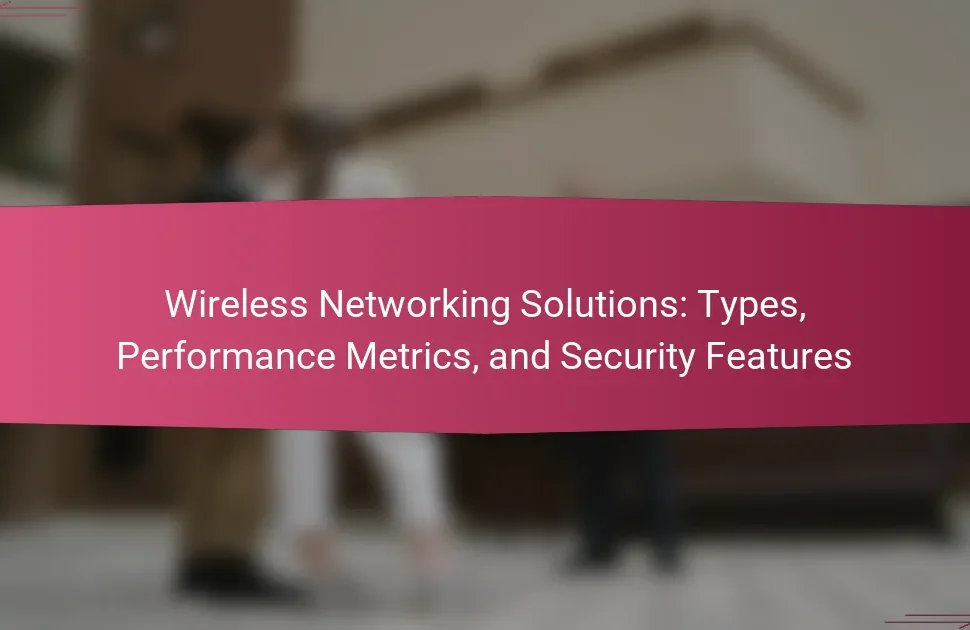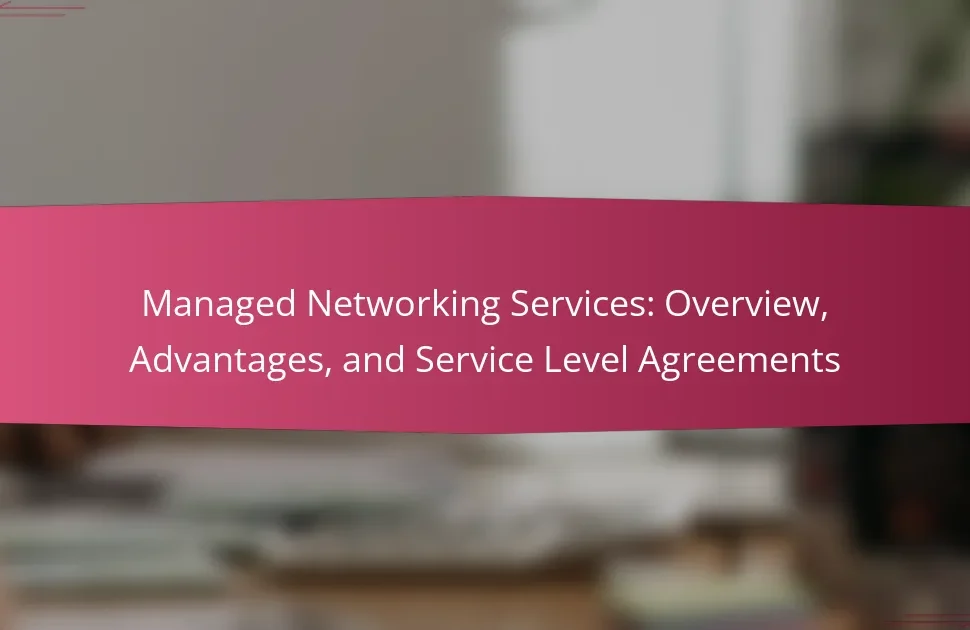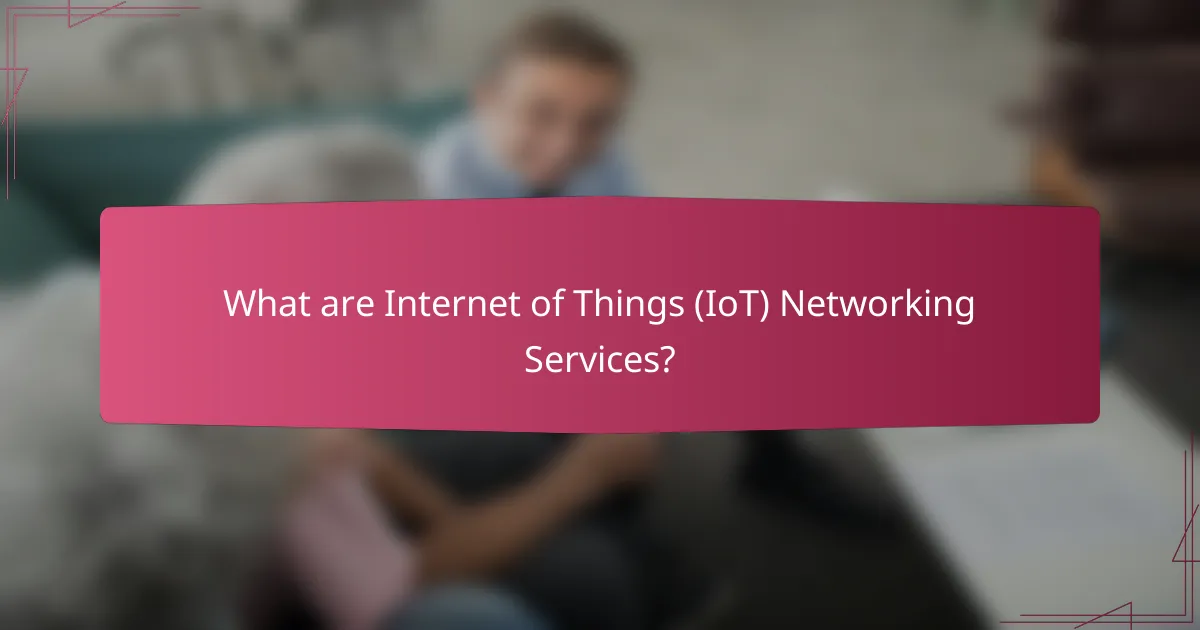
What are Internet of Things (IoT) Networking Services?
Internet of Things (IoT) Networking Services are solutions that enable connectivity among IoT devices. These services facilitate communication between devices, networks, and cloud services. They include various technologies such as cellular, Wi-Fi, and LPWAN. IoT networking services ensure data transmission and device management. They also incorporate security measures to protect data integrity. Scalability is a key feature, allowing networks to grow with increasing device numbers. These services are essential for effective IoT applications across industries.
How do IoT Networking Services enable device communication?
IoT Networking Services enable device communication by providing the infrastructure necessary for data exchange. These services facilitate connectivity between devices through various protocols like MQTT, CoAP, and HTTP. They ensure that devices can send and receive data reliably over the internet. IoT Networking Services also manage device identification and authentication, enhancing security during communication. Additionally, they support scalability by accommodating numerous devices within a network without compromising performance. According to a report by Gartner, effective IoT networking can reduce latency and improve response times in device interactions.
What technologies are involved in IoT Networking Services?
IoT Networking Services involve various technologies essential for connectivity and communication. Key technologies include wireless protocols such as Wi-Fi, Bluetooth, Zigbee, and LoRaWAN. These protocols facilitate device communication over short and long ranges. Cellular technologies like 4G and 5G also play a significant role in providing robust connectivity. Additionally, edge computing is utilized to process data closer to the source, reducing latency. Cloud computing supports data storage and analytics for IoT applications. Security technologies, including encryption and secure authentication, are critical to protect data integrity. Collectively, these technologies enable seamless interaction between IoT devices and networks.
How do protocols impact IoT Networking Services?
Protocols significantly impact IoT networking services by defining how devices communicate and exchange data. They ensure interoperability among diverse devices, enabling seamless integration within IoT ecosystems. Protocols like MQTT and CoAP optimize data transmission, reducing latency and bandwidth usage. This efficiency is crucial in environments with limited resources, enhancing overall performance. Security protocols, such as TLS, protect data integrity and confidentiality during transmission. These measures are vital for maintaining user trust and safeguarding sensitive information. In summary, protocols are foundational to the functionality, efficiency, and security of IoT networking services.
What are the key components of IoT Networking Services?
The key components of IoT networking services include connectivity, protocols, security, and data management. Connectivity refers to the methods used to link devices, such as Wi-Fi, cellular, and LPWAN. Protocols define communication standards, with MQTT and CoAP being popular choices. Security encompasses measures to protect data, including encryption and authentication. Data management involves collecting, storing, and analyzing data generated by IoT devices. These components work together to enable efficient and secure IoT operations.
What role do gateways play in IoT Networking Services?
Gateways act as critical intermediaries in IoT networking services. They facilitate communication between IoT devices and cloud services. Gateways manage data traffic, ensuring efficient data transmission. They also perform protocol translation, allowing devices with different communication protocols to interact. Additionally, gateways enhance security by filtering data and implementing encryption. According to a report by Gartner, gateways play a vital role in enabling interoperability among diverse IoT devices. This functionality is essential for scalable IoT deployments.
How do cloud services integrate with IoT Networking Services?
Cloud services integrate with IoT networking services by providing scalable data storage and processing capabilities. These services enable real-time data analytics from IoT devices. Cloud platforms facilitate device management and connectivity through APIs and SDKs. They support various communication protocols like MQTT and HTTP for seamless interaction. Security measures are enhanced through cloud-based encryption and authentication. This integration allows for efficient data transfer and remote monitoring. According to a report by McKinsey, cloud services can improve IoT deployment efficiency by up to 30%. This demonstrates the crucial role of cloud services in optimizing IoT networking.
What challenges are faced in IoT Networking Services?
IoT Networking Services face several challenges. Key issues include security vulnerabilities, as devices often lack robust protection. Scalability is another concern, with networks struggling to accommodate increasing device numbers. Interoperability issues arise due to diverse protocols and standards across devices. Network latency can hinder real-time data processing and application performance. Additionally, bandwidth limitations can affect data transmission efficiency. Power consumption is a challenge, especially for battery-operated devices. Finally, regulatory compliance can complicate deployment and operation of IoT solutions. Each of these challenges impacts the effectiveness of IoT Networking Services.
How does network congestion affect IoT performance?
Network congestion negatively impacts IoT performance by causing delays and data loss. When many devices transmit data simultaneously, the network can become overloaded. This overload results in increased latency, which affects real-time applications. IoT devices often require timely data transmission for effective operation. High latency can lead to slow response times and degraded user experience. Additionally, congestion can cause packet loss, where data packets fail to reach their destination. This loss can disrupt communication between devices, leading to incomplete data collection. Studies have shown that network congestion can reduce IoT system efficiency by up to 30%. Thus, managing network traffic is crucial for optimal IoT functionality.
What are the limitations of current IoT Networking Services?
Current IoT networking services face several limitations. One major limitation is scalability. As the number of connected devices increases, managing network traffic becomes challenging. Another limitation is security vulnerabilities. Many IoT devices lack robust security measures, making them susceptible to cyberattacks. Additionally, interoperability issues arise due to the diversity of IoT protocols. This hampers seamless communication between devices from different manufacturers. Furthermore, bandwidth constraints can affect performance. Many IoT applications require real-time data transmission, which may be hindered by limited bandwidth. Lastly, latency can be a significant concern. High latency impacts the responsiveness of IoT applications, particularly in critical use cases like healthcare and autonomous vehicles.
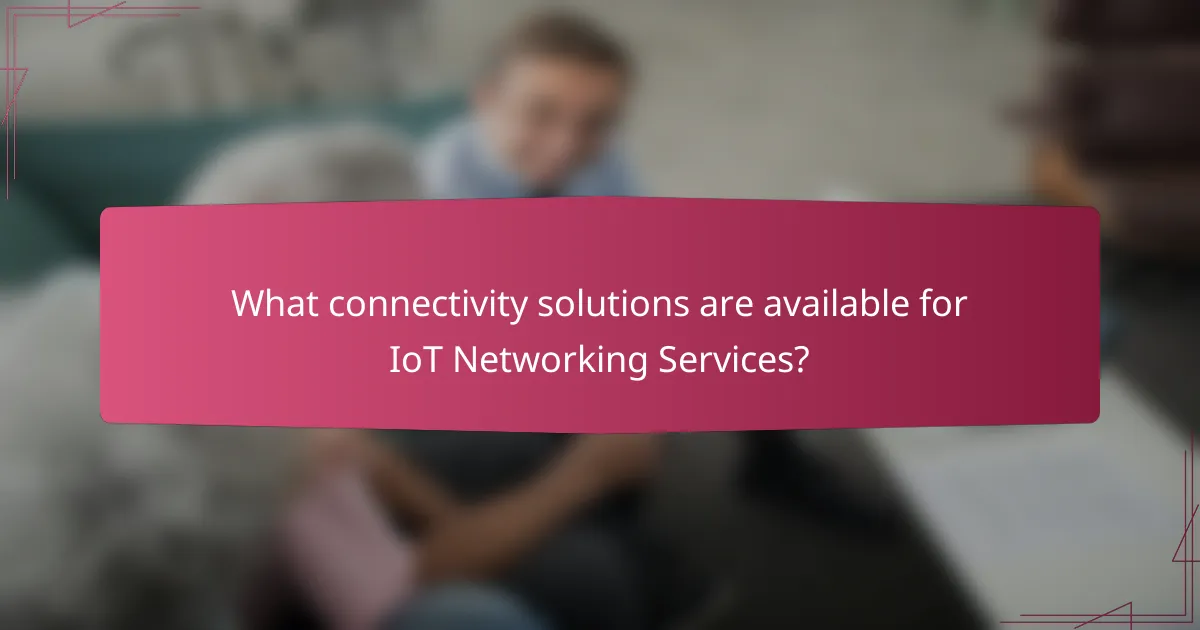
What connectivity solutions are available for IoT Networking Services?
Connectivity solutions for IoT Networking Services include cellular, Wi-Fi, LoRaWAN, and Zigbee. Cellular connectivity utilizes mobile networks for wide coverage and high data rates. Wi-Fi offers high-speed internet access in localized areas. LoRaWAN is designed for long-range, low-power applications, ideal for remote sensors. Zigbee is suitable for short-range communication in smart home devices. Each solution addresses specific use cases and requirements in IoT deployments.
How do different connectivity technologies compare?
Different connectivity technologies vary in speed, range, power consumption, and application suitability. For instance, Wi-Fi offers high-speed internet with a range of about 100-300 feet. It is suitable for indoor applications but consumes significant power. Cellular networks provide extensive coverage and mobility, ideal for outdoor IoT devices, but have higher latency and costs. LoRaWAN excels in long-range communication with low power consumption, making it suitable for battery-operated devices. Zigbee operates over short distances and is energy-efficient, perfect for home automation. Each technology’s performance metrics, such as data rates and coverage areas, influence their selection for specific IoT applications.
What are the advantages of using cellular connectivity for IoT?
Cellular connectivity offers several advantages for IoT applications. It provides extensive coverage, enabling devices to connect in urban and rural areas. Cellular networks support mobility, allowing IoT devices to remain connected while in motion. Security is enhanced through established encryption protocols used in cellular communications. Scalability is facilitated, as cellular networks can accommodate a large number of devices without significant infrastructure changes. Additionally, cellular IoT technologies, such as LTE-M and NB-IoT, are optimized for low power consumption, extending battery life for connected devices. These benefits make cellular connectivity a robust choice for diverse IoT deployments.
How does LPWAN differ from traditional networking solutions?
LPWAN (Low Power Wide Area Network) differs from traditional networking solutions primarily in its design for long-range communication and low power consumption. Traditional networks often require higher bandwidth and energy, making them less suitable for IoT applications. LPWAN can connect devices over distances of up to 15 kilometers in rural areas, while traditional networks typically cover shorter ranges. Additionally, LPWAN supports a large number of devices simultaneously, often thousands per base station, which is a significant advantage over traditional networks. This scalability is crucial for IoT deployments, where numerous sensors or devices are often in use. Furthermore, LPWAN technologies, such as LoRa and Sigfox, are optimized for low data rates, which is sufficient for many IoT applications. In contrast, traditional networks prioritize higher data rates for applications like video streaming or large file transfers. These differences make LPWAN a more efficient choice for specific IoT use cases, particularly in remote or hard-to-reach areas.
What factors influence the choice of connectivity solution?
The choice of connectivity solution is influenced by several factors. Key factors include bandwidth requirements, latency sensitivity, coverage area, and network reliability. Bandwidth requirements determine how much data can be transmitted simultaneously. Latency sensitivity affects applications that require real-time data processing. Coverage area is critical for devices operating in remote locations. Network reliability ensures consistent performance and uptime. Additional considerations include cost, scalability, and compatibility with existing infrastructure. Each factor plays a significant role in selecting the most suitable connectivity solution for IoT applications.
How do range and bandwidth requirements affect connectivity selection?
Range and bandwidth requirements significantly influence connectivity selection in IoT networking. Range determines how far a signal can travel, impacting the choice between local and wide-area networks. For example, short-range technologies like Bluetooth are suitable for devices within a few meters. In contrast, long-range options like LoRaWAN cover several kilometers, making them ideal for remote sensors.
Bandwidth refers to the data transfer rate of a connection. High-bandwidth requirements necessitate technologies like Wi-Fi or 5G, which can handle large data volumes quickly. Conversely, low-bandwidth applications can utilize simpler protocols like Zigbee, which are efficient for small data packets.
The interplay between range and bandwidth dictates the overall effectiveness of the connectivity solution. A balance must be struck to ensure optimal performance without unnecessary costs. For instance, a smart home device may require Wi-Fi for high bandwidth but only needs a short range, making it suitable for local connectivity. Thus, understanding these requirements is crucial for selecting the appropriate IoT connectivity solution.
What is the impact of device density on connectivity solutions?
Device density significantly impacts connectivity solutions. Higher device density can lead to network congestion. This congestion may result in reduced bandwidth availability. Increased interference among devices can occur in densely populated environments. Latency may also increase, affecting real-time applications. Network protocols must adapt to manage more connections efficiently. Solutions like edge computing can mitigate these challenges. Studies show that optimizing network architecture improves performance in high-density scenarios.
What are the emerging trends in IoT connectivity?
Emerging trends in IoT connectivity include the rise of 5G technology, which offers faster speeds and lower latency. This enables real-time data processing for IoT devices. Another trend is the adoption of edge computing. It allows data processing closer to the source, reducing bandwidth usage and improving response times. Additionally, the implementation of LPWAN (Low Power Wide Area Network) technologies is gaining traction. These networks are designed for long-range communication with low power consumption, ideal for IoT applications. Furthermore, increased focus on security measures is evident. Enhanced encryption and authentication protocols are being developed to protect IoT devices from cyber threats. Lastly, interoperability among devices is becoming crucial. Standardized communication protocols are being established to ensure seamless connectivity across diverse IoT ecosystems.
How is 5G expected to transform IoT Networking Services?
5G is expected to transform IoT networking services by providing enhanced connectivity, lower latency, and increased capacity. This technology allows for a higher density of devices to connect simultaneously. With 5G, IoT devices can communicate in real-time, improving responsiveness. The expected latency is as low as 1 millisecond, which is crucial for applications like autonomous vehicles. 5G networks can support up to 1 million devices per square kilometer. This scalability addresses the growing demand for connected devices in smart cities and industries. Overall, 5G significantly enhances the performance and reliability of IoT networking services.
What role do satellite communications play in IoT connectivity?
Satellite communications provide essential connectivity for IoT devices, especially in remote or rural areas. They enable data transmission where terrestrial networks are unavailable or unreliable. Satellite networks can cover vast geographical areas, making them ideal for global IoT applications. For instance, they support agriculture, logistics, and environmental monitoring in hard-to-reach locations. According to a report by the International Telecommunication Union, satellite IoT connectivity can enhance network resilience and redundancy. This ensures continuous data flow even during terrestrial network failures. Thus, satellite communications play a critical role in expanding the reach and reliability of IoT connectivity.
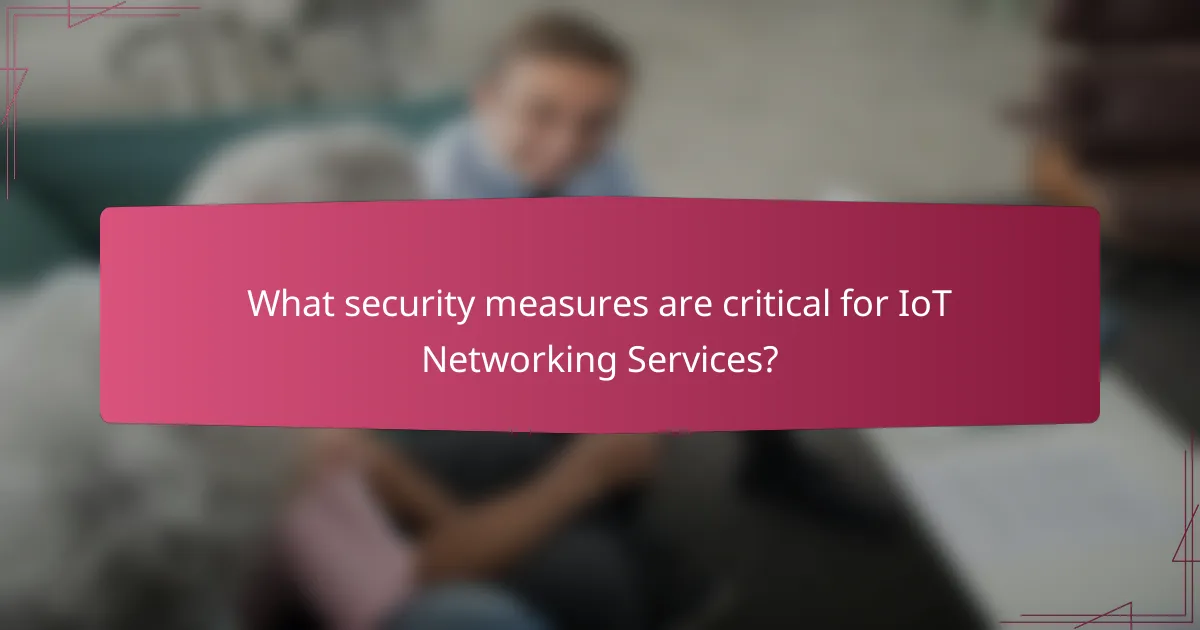
What security measures are critical for IoT Networking Services?
Critical security measures for IoT Networking Services include device authentication, data encryption, and network security protocols. Device authentication ensures that only authorized devices can connect to the network. This can prevent unauthorized access and potential breaches. Data encryption protects sensitive information transmitted between devices. It ensures that even if data is intercepted, it remains unreadable to attackers. Network security protocols, such as firewalls and intrusion detection systems, monitor and protect the network from malicious activities. According to a 2021 report by McKinsey, 75% of IoT security breaches occur due to inadequate device authentication and encryption. This highlights the importance of implementing these security measures effectively.
How do vulnerabilities in IoT devices affect security?
Vulnerabilities in IoT devices significantly compromise security. These weaknesses can be exploited by attackers to gain unauthorized access. For example, insecure default passwords often allow easy entry into networks. Additionally, outdated firmware can leave devices exposed to known threats. Research shows that 98% of IoT devices have at least one vulnerability. This widespread issue increases the risk of data breaches. Consequently, compromised devices can be used in larger attacks, such as DDoS. Therefore, addressing these vulnerabilities is crucial for maintaining overall network security.
What are the most common security threats to IoT networks?
The most common security threats to IoT networks include unauthorized access, data breaches, and device hijacking. Unauthorized access occurs when attackers exploit weak authentication protocols. Data breaches can happen due to insufficient encryption, allowing sensitive information to be intercepted. Device hijacking involves taking control of IoT devices for malicious purposes, such as launching DDoS attacks. Additionally, IoT networks face threats from malware designed specifically for IoT devices. These threats are exacerbated by the lack of regular software updates and patches. According to a 2021 report by Cybersecurity Ventures, IoT attacks are expected to increase significantly, highlighting the urgent need for robust security measures.
How can device authentication enhance IoT security?
Device authentication enhances IoT security by verifying the identity of devices before they connect to a network. This process ensures that only authorized devices can access sensitive data and services. By implementing strong authentication protocols, such as digital certificates or cryptographic keys, the risk of unauthorized access is significantly reduced.
Research indicates that over 70% of IoT security breaches occur due to improper device authentication. Regularly updating authentication methods can further strengthen security. Additionally, device authentication helps in monitoring and managing devices on the network, making it easier to detect anomalies. This proactive approach contributes to a more secure IoT ecosystem.
What best practices should be implemented for IoT security?
Implementing best practices for IoT security involves several key strategies. First, change default passwords on devices to unique, strong passwords. This prevents unauthorized access from easily guessed credentials. Second, regularly update device firmware and software. Keeping systems updated mitigates vulnerabilities that could be exploited by attackers. Third, use encrypted communication protocols. Encryption secures data transmission between devices and reduces the risk of interception. Fourth, segment IoT devices on separate networks. This limits the potential damage if one device is compromised. Fifth, implement strong authentication methods. Multi-factor authentication adds an extra layer of security for device access. Finally, monitor and log device activity continuously. This helps detect unusual behavior that may indicate a security breach. These practices are essential for maintaining a robust IoT security posture.
How can encryption protect data in IoT Networking Services?
Encryption protects data in IoT Networking Services by securing information during transmission. It ensures that data sent between devices is unreadable to unauthorized users. This process involves transforming plaintext into ciphertext using algorithms. Only authorized devices with the correct decryption keys can access the original data.
Encryption also helps maintain data integrity. It verifies that the information has not been altered during transmission. Additionally, it provides authentication, confirming the identity of the devices involved in communication. According to a study by the National Institute of Standards and Technology, encryption is a critical component for safeguarding sensitive data in IoT environments.
The implementation of encryption protocols, such as AES (Advanced Encryption Standard), is widely recommended for IoT applications. These protocols can significantly reduce the risk of data breaches and unauthorized access.
What role do regular software updates play in maintaining security?
Regular software updates are crucial for maintaining security. They patch vulnerabilities that could be exploited by attackers. For example, a study by the Ponemon Institute found that 60% of breaches resulted from unpatched vulnerabilities. Updates also enhance existing security features, making systems more resilient. Additionally, they often include new security protocols to combat emerging threats. Without these updates, devices become increasingly susceptible to malware and hacking attempts. Therefore, regular updates are essential to ensure the ongoing security of IoT devices and networks.
What are the implications of regulatory compliance for IoT security?
Regulatory compliance for IoT security ensures adherence to legal and industry standards. It establishes a framework for protecting sensitive data and maintaining user privacy. Compliance mandates often include guidelines for encryption, access controls, and vulnerability management. Organizations face penalties for non-compliance, which can include fines and reputational damage. For instance, the General Data Protection Regulation (GDPR) requires strict data handling practices. Failure to comply can lead to fines up to €20 million or 4% of global annual revenue. Regulatory compliance also drives innovation in security technologies. It encourages companies to adopt best practices and improve overall security posture. Thus, regulatory compliance is crucial for safeguarding IoT ecosystems.
How do GDPR and CCPA impact IoT Networking Services?
GDPR and CCPA impose strict data protection regulations that significantly impact IoT networking services. These regulations require IoT service providers to ensure user consent before collecting personal data. They also mandate transparency regarding data usage and storage practices. IoT devices must be designed with privacy in mind, incorporating features like data encryption and anonymization. Non-compliance can lead to substantial fines and legal repercussions. For instance, GDPR fines can reach up to €20 million or 4% of annual global revenue, while CCPA can impose penalties of up to $7,500 per violation. Thus, adherence to these regulations is crucial for maintaining user trust and avoiding financial penalties in IoT networking services.
What are the challenges of achieving compliance in IoT?
Achieving compliance in IoT faces several challenges. One major challenge is the lack of standardized regulations. Different regions have varying compliance requirements, complicating global deployment. Additionally, the rapid pace of technological advancement outstrips regulatory frameworks. This creates gaps in compliance measures. Security vulnerabilities in IoT devices further complicate compliance efforts. Many devices lack robust security features, making them susceptible to breaches. Data privacy concerns also pose significant challenges. Ensuring user data protection while maintaining functionality is difficult. Lastly, resource constraints can hinder compliance efforts. Many organizations lack the necessary expertise and budget to navigate compliance effectively.
What scalability challenges do IoT Networking Services face?
IoT Networking Services face several scalability challenges. One major challenge is the limited bandwidth available for data transmission. As the number of connected devices increases, the demand for bandwidth grows, leading to potential network congestion. Another challenge is the need for efficient data processing. With vast amounts of data generated by IoT devices, processing this data in real-time can strain resources. Additionally, interoperability issues arise due to the diverse range of devices and protocols used in IoT. This can complicate integration and management of networks as they scale. Security concerns also escalate with increased scalability. More devices mean a larger attack surface, making it crucial to implement robust security measures. Lastly, the physical infrastructure may become inadequate as the network expands. Upgrading or expanding infrastructure can be costly and time-consuming. These challenges highlight the complexities involved in scaling IoT Networking Services effectively.
How does increasing device count affect network performance?
Increasing device count negatively affects network performance. As more devices connect to a network, bandwidth becomes limited. This leads to increased latency and slower data transfer speeds. Network congestion occurs when too many devices attempt to communicate simultaneously. Each device consumes a portion of the available bandwidth. For example, a network with a 100 Mbps connection will have reduced speeds for each device as more devices join. Research indicates that performance degradation can be significant, with studies showing up to a 50% decrease in speed with excessive device connections. Additionally, increased device count can strain network infrastructure, leading to higher packet loss rates.
What strategies can be used to manage scalability in IoT?
Strategies to manage scalability in IoT include implementing edge computing, utilizing cloud services, and adopting efficient data management practices. Edge computing reduces latency by processing data closer to the source. This approach minimizes bandwidth usage and enhances response times. Cloud services offer scalable infrastructure that can grow with demand. They provide on-demand resources, allowing for flexible scaling. Efficient data management practices involve filtering and aggregating data before transmission. This reduces the volume of data sent to the cloud. Additionally, using standardized protocols ensures interoperability among devices. These strategies collectively enhance the scalability of IoT systems, ensuring they can accommodate growth without performance degradation.
What are the future considerations for scaling IoT Networking Services?
Future considerations for scaling IoT Networking Services include enhanced network capacity, improved security protocols, and interoperability among devices. Increased device connectivity demands higher bandwidth and lower latency. Advanced technologies like 5G and edge computing will support these needs. Security measures must evolve to protect against rising cyber threats. Implementing robust encryption and authentication is critical. Interoperability ensures diverse devices communicate seamlessly. Standardization across platforms can facilitate this integration. Additionally, regulatory compliance will shape service scalability. Adapting to evolving regulations is essential for sustainable growth.
How can edge computing enhance scalability in IoT?
Edge computing enhances scalability in IoT by processing data closer to the source. This reduces latency and bandwidth usage. Edge devices can handle local data processing, which alleviates the load on central servers. By distributing computing resources, edge computing allows for more devices to connect simultaneously. According to a study by Gartner, edge computing can reduce data transmission costs by up to 50%. This efficiency supports the growing number of IoT devices. Consequently, organizations can scale their IoT deployments without significant infrastructure changes.
What role does network slicing play in IoT scalability?
Network slicing enables efficient IoT scalability by creating multiple virtual networks within a single physical infrastructure. Each slice can be tailored to meet the specific requirements of different IoT applications. This customization allows for optimized resource allocation, ensuring that devices with varying needs can operate simultaneously without interference. For instance, critical applications requiring low latency can be allocated their own slice, while less critical applications can share another. According to research by the 3rd Generation Partnership Project (3GPP), network slicing can support up to 1 million devices per square kilometer. This capability significantly enhances the scalability of IoT networks, accommodating the exponential growth of connected devices.
What practical tips can help organizations optimize IoT Networking Services?
Organizations can optimize IoT Networking Services by implementing several practical tips. First, they should ensure robust network architecture to handle increased device connectivity. This includes using edge computing to process data closer to devices, reducing latency. Second, organizations must prioritize security measures such as end-to-end encryption and regular software updates to protect against vulnerabilities. Third, they should adopt scalable solutions that can grow with their IoT deployments, enabling seamless integration of new devices. Fourth, utilizing data analytics can help in monitoring network performance and identifying bottlenecks. Finally, organizations should engage in continuous training for their teams to stay updated on the latest IoT technologies and best practices. These strategies collectively enhance the efficiency and security of IoT networking services.
The main entity of this article is Internet of Things (IoT) Networking Services, which encompass solutions that enable connectivity among IoT devices through various technologies such as cellular, Wi-Fi, and LPWAN. The article provides an overview of how these services facilitate device communication, the key technologies involved, and the critical protocols that ensure efficient and secure data exchange. It also addresses the challenges of scalability, security vulnerabilities, and the implications of regulatory compliance in IoT networking. Additionally, the article explores emerging trends, such as the integration of 5G technology and edge computing, which are poised to transform IoT connectivity and performance.



